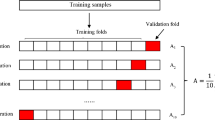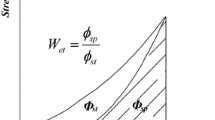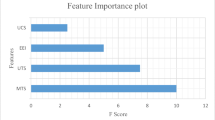Abstract
Due to the complex mechanisms of rockburst, there is no current effective method to reliably predict these events. A statistical learning method, support vector machine (SVM), is employed in this paper for kimberlite burst prediction. Four indicators \(\sigma_{\theta } ,\sigma_{c} ,\sigma_{t} ,W_{\text{ET}}\) are chosen as input indices for the SVM, which is trained using 108 groups of rockburst cases from around the world. Data uniformization is used to avoid negative impact of differing dimensions across the original data. Parameter optimization is embedded in the training process of the SVM to achieve optimized predictive ability. After training and optimization, the SVM reaches an accuracy of 95% in rock burst prediction for validation samples. The constructed SVM is then employed in kimberlite burst liability evaluation. The model indicated a moderate burst risk, which matches observed instances of rockburst at a diamond mine in north Canada. The SVM method ignores the focus on rockburst mechanisms, instead relying on representative indicators to develop a predictive model through self-learning. The prediction results show an excellent accuracy, which means this method has a potential application in rockburst prediction.



Similar content being viewed by others
References
Adoko AC, Gokceoglu C, Wu L, Zuo QJ (2013) Knowledge-based and data-driven fuzzy modeling for rockburst prediction. Int J Rock Mech Min Sci 61:86–95
Altindag R (2003) Correlation of specific energy with rock brittleness concepts on rock cutting. J S Afr Inst Min Metall 103(3):163–171
Bai M, Wang L, Xu Z (2002) Study on a neutral network model and its application in predicting the risk of rock burst. China Saf Sci J 12(4):65–69
Baltz R, Hucke A (2008) Rockburst prevention in the German coal industry. In: Proceedings of the 27th international conference on ground control in mining. West Virginia University, Morgantown, pp 46–50
Blake W, Hedley DGF (2003) Rockbursts: case studies from North American hard-rock mines. SME
Cai W, Dou L, Si G, Cao A, He J, Liu S (2016) A principal component analysis/fuzzy comprehensive evaluation model for coal burst liability assessment. Int J Rock Mech Min Sci 81:62–69
Chang C-C, Lin C-J (2011) LIBSVM: a library for support vector machines. ACM Trans Intell Syst Technol 2(3):27
Cortes C, Vapnik V (1995) Support-vector networks. Mach Learn 20(3):273–297
Dong L-J, Li X-B, Kang P (2013) Prediction of rockburst classification using Random Forest. Trans Nonferr Metals Soc China 23(2):472–477
Dong L, Li X, Xie G (2014) Nonlinear methodologies for identifying seismic event and nuclear explosion using random forest, support vector machine, and naive Bayes classification. In: Abstract and applied analysis, vol 2014. Hindawi Publishing Corporation, London, UK
Duan K, Keerthi SS (2005) Which is the best multiclass SVM method? An empirical study. Multiple classifier systems 3541:278–285
Feng X-T, Wang L (1994) Rockburst prediction based on neural networks. Trans Nonferr Metals Soc China 4(1):7–14
Feng X, Zhao H (2002) Prediction of rockburst using support vector machine. J Northeast Univ (Nat Sci) 01:57–59 (in Chinese)
Gibowicz SJ (2009) Seismicity induced by mining: recent research. Adv Geophys 51:1–53
Jaeger JC, Cook NG, Zimmerman R (2009) Fundamentals of rock mechanics. Wiley, New York
James G, Witten D, Hastie T, Tibshirani R (2013) An introduction to statistical learning, vol 112. Springer, Berlin
Kabwe E, Wang Y (2015) Review on rockburst theory and types of rock support in rockburst prone mines. Open J Saf Sci Technol 5(04):104
Kaytez F, Taplamacioglu MC, Cam E, Hardalac F (2015) Forecasting electricity consumption: a comparison of regression analysis, neural networks and least squares support vector machines. Int J Electr Power Energy Syst 67:431–438
Kidybiński A (1981) Bursting liability indices of coal. Int J Rock Mech Min Sci Geomech Abstr 18(4):295–304
Kodratoff Y (2014) Introduction to machine learning. Morgan Kaufmann, Los Altos
Leveille P, Sepehri M, Apel DB (2016) Rockbursting potential of kimberlite: a case study of Diavik diamond mine. Rock Mech Rock Eng 50:1–9
Li H, Li Z, He R, Yan Y (2014) Rock burst risk evaluation based on particle swarm optimization and BP neural network. J Min Saf Eng 31(2):203–231 (in Chinese)
Liang Z (2004) Study on the prediction and prevention of rockburst in the diversion tunnel of Jinping II Hydropower Station. Chengdu Univ Technol Chendu, Sc
Liu Z, Yuan Q, Li J (2008) Application of fuzzy probability model to prediction of classification of rockburst intensity. Chin J Rock Mech Eng 27(Supp. 1):3095–3103
Mengguo X, Zijian D, Gaohui Y, Zhenping L (2008) Rockburst prediction of chengchao iron mine during deep mining. Chin J Rock Mech Eng 27(s1):2921–2928
Mitri HS, Hughes R, Zhang Y (2011) New rock stress factor for the stability graph method. Int J Rock Mech Min Sci 48(1):141–145
Potvin Y, Hudyma M, Jewell RJ (2000) Rockburst and seismic activity in underground Australian mines—an introduction to a new research project. In: ISRM international symposium, international society for rock mechanics
Pu Y, Apel D, Xu H (2018) A principal component analysis/fuzzy comprehensive evaluation for rockburst potential in kimberlite. Pure Appl Geophys 175:1–11
Qiang S, Yi-Shan P, Yi-Jie L (2005) The typical cases and analysis of rockburst in China. Coal Min Technol 10(2):13–17 (in Chinese)
Qin S, Chen J, Wang Q (2009) Research on rockburst prediction with extenics evaluation based on rough set. In: Proceedings of the 13th international symposium on rockburst and seismicity in mines. Rinton Press, Dalian, pp 937–944
Sepehri M, Apel D, Liu W (2017) Stope stability assessment and effect of horizontal to vertical stress ratio on the yielding and relaxation zones around underground open stopes using empirical and finite element methods. Arch Min Sci 62(3):653–669
Steinwart I, Christmann A (2008) Support vector machines. Springer, Berlin
Su G, Zhang Y, Chen G (2010) Identify rockburst grades for Jinping II hydropower station using Gaussian process for binary classification. In: International conference on computer, mechatronics, control and electronic engineering (CMCE), Vol 2, pp 364–367, IEEE
Vallejos J, McKinnon S (2013) Logistic regression and neural network classification of seismic records. Int J Rock Mech Min Sci 62:86–95
Wang Y-H, Li W, Li Q, Xu Y, Tan G (1998) Method of fuzzy comprehensive evaluations for rockburst prediction. Chin J Rock Mech Eng 17(5):493–501
Wang X, Li X, Gu Y, Jin X, Kang Y, Li D (2004) Application of BP neural network into prediction of rockburst in tunneling. In: Proceedings of the 2004 international symposiumon safety science and technology 4:617–621
Xu J, Jiang J, Xu N, Liu Q, Gao Y (2017) A new energy index for evaluating the tendency of rockburst and its engineering application. Eng Geol 230:46–54
Yang J, Li X, Zhou Z, Lin Y (2010) A Fuzzy assessment method of rock-burst prediction based on rough set theory. Jinshu Kuangshan/Metal Mine (6):26–29
Yi Y, Cao P, Pu C (2010) Multi-factorial comprehensive estimation for Jinchuan’s deep typical rockburst tendency. Sci Technol Rev 28(2):76–80
Yi-Peng J, Qing L, Yue-Quan S (2013) Rockburst prediction using particle swarm optimization algorithm and general regression neural network. Chin J Rock Mech Eng 32(2):343–348 (in Chinese)
Zhang J (2007) Study on prediction by stages and control technology of rockburst hazard of Daxiangling highway tunnel. M. Sc. Thesis. Southwest Jiaotong University, Chendu (in Chinese)
Zhang L-X, Li C-H (2009) Study on tendency analysis of rockburst and comprehensive prediction of different types of surrounding rock. In: Tang CA (ed) RaSiM 7: controlling seismic hazard and sustainable development of deep mines. Rinton Press, pp 1451–1456
Zhang L, Zhang D, Qiu D (2010) Application of extension evaluation method in rockburst prediction based on rough set theory. J China Coal Soc 35(9):1461–1465
Zhou J, Li X, Shi X (2012) Long-term prediction model of rockburst in underground openings using heuristic algorithms and support vector machines. Saf Sci 50(4):629–644
Author information
Authors and Affiliations
Corresponding author
Rights and permissions
About this article
Cite this article
Pu, Y., Apel, D.B., Wang, C. et al. Evaluation of burst liability in kimberlite using support vector machine. Acta Geophys. 66, 973–982 (2018). https://doi.org/10.1007/s11600-018-0178-2
Received:
Accepted:
Published:
Issue Date:
DOI: https://doi.org/10.1007/s11600-018-0178-2




